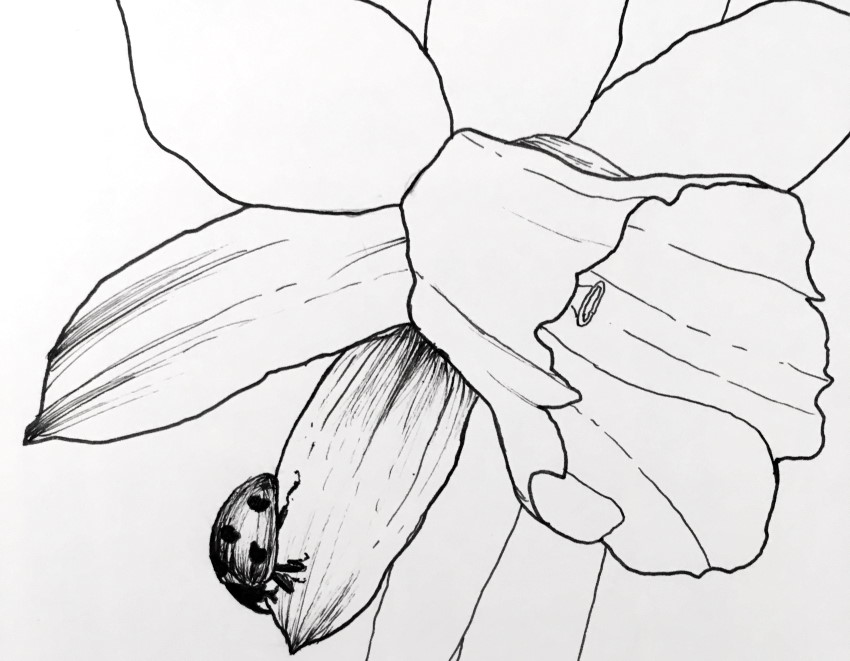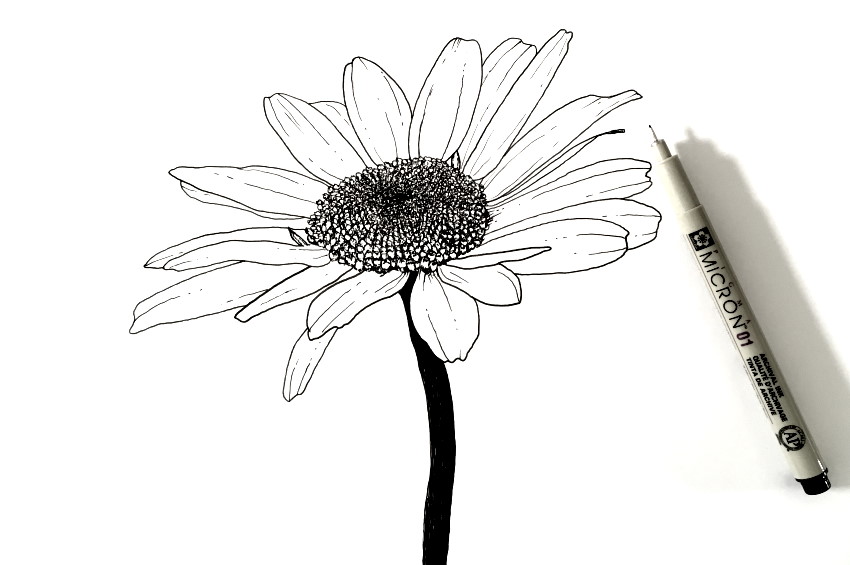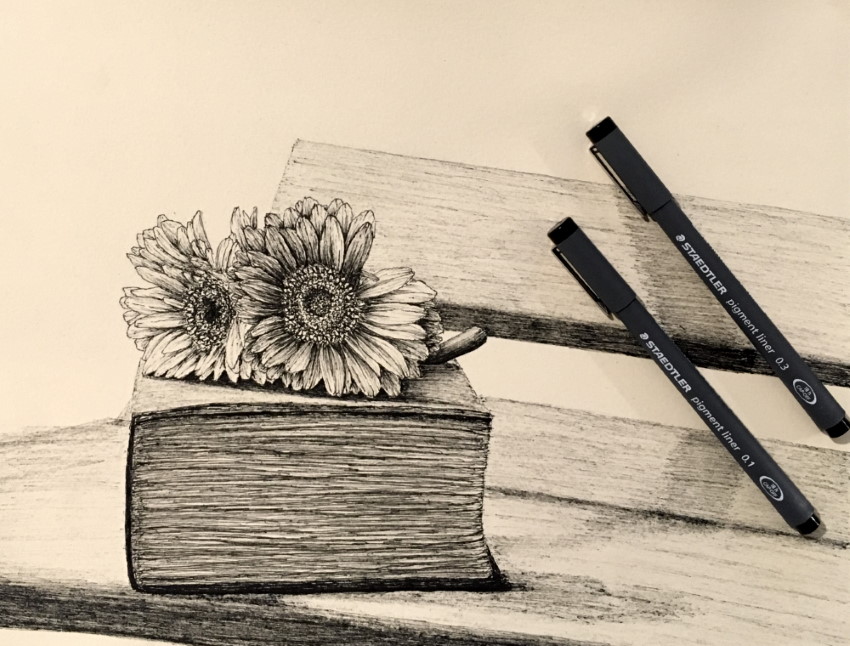Flower Drawing Guide
Updated: 19 Jun 2025

In this guide, I demonstrate how to draw any flower, from simple to complex, using a pen.
Well-executed flower pen-drawing is all about accuracy of the structure (form), with attention to foreshortening and overlapping.
Concept Art
Avoid using concept images that are protected by copyright law.
In case someone likes your drawing and wants to buy it, it is best to use images that are free for ANY use.
Here are some websites that let you download FREE stock images:
*Taking your own photos is the best solution to creating unique drawings and compositions.
Smooth Lines with a Pen
For a pen drawing to look nice, draw each mark with confidence. Meaning a smooth line.
That is easier said than done!
With time and practice, the lines will flow. Until then, start with a pencil.
The advantage of a pencil is that it is erasable. Therefore, you can fix mistakes until you are happy with the result.
So grab your reference image and draw it with a pencil. Draw it gently, so it will be easy to erase later.
Note:
The pencil drawing does not have to be perfect. Remember that nature is abstract. There are no two identical flowers.
 Reference image & pencil sketch
Reference image & pencil sketch
Once the pencil sketch is ready, it is easy to go over it with a pen. Do it in a confident and smooth way, even if the pen marks are not exactly on top of the pencil marks.
When drawing with a pen, it is important to pay attention to overlap.
Draw the foreground parts first. In this case, draw the stamens first and only then draw the petals.
After the ink from the pen is dry (usually less than a minute, depending on the pen brand), it is safe to gently erase the pencil-drawing marks.
 Hellebore flower pen drawing
Hellebore flower pen drawing
Complex Flower
Some flowers or compositions are quite complex. You should pay attention to proportions, foreshortening, and perspective.
This is too much to deal with when starting to draw.
A solution to this problem is to create a grid of guidelines. Then, instead of one complex image, you have several smaller and simpler images.
To find the middle point of an image, draw two diagonal lines from the image's corners.
Next, draw horizontal and vertical lines from the midpoint.
 Finding the center & creating a grid
Finding the center & creating a grid
Do the same for the drawing paper. Make sure the ratio between height and width is the same for both the reference image and the drawing paper.
You can crop the reference image to get the same ratio.
Now it is easier to draw with a pencil.
Note:
If the image is still complex for you, you can keep adding grid lines for each rectangle.
 Drawing with a pencil
Drawing with a pencil
Remember to use the pencil gently. It will be easier to erase after you draw with a pen.
 Lily flower pen drawing
Lily flower pen drawing
Good to know:
If you do not fully understand terms like overlapping, perspective, and foreshortening, I highly recommend reading my guide on drawing the illusion of depth.
Drawing Pens
While you can draw or sketch with a regular pen, there are many advantages to using pens for artists.
These pens are called fine liners or technical pens, and their ink is usually black, though some brands offer additional colors (more on that later).
 Fine liners
Fine liners
Pens for artists create lines of uniform thickness, and they come in different sizes, therefore enabling them to draw thick contour lines or thin lines for details.
The ink of these pens is made of pigments, and it is very durable.
I mostly use pens with a 0.1 nib size. It is small and allows me to draw fine details.
To learn more about which pen to use, visit my review for recommended pen brands for drawing.
Line Width and Size
When drawing with a pencil, you can draw soft edges for far away objects.
Pens have one brightness value and therefore cannot produce soft edges.
Instead, you can use a pen with a smaller nib size to create thinner lines for background objects and a bigger nib size to create thicker lines for foreground objects.
 Different nib sizes
Different nib sizes
Using lines with different thicknesses to add depth:
 Tulip flowers
Tulip flowers
Another way to add depth is with size.
When drawing in perspective, the farther away an object is, the smaller it looks.
For that reason, draw bigger flowers in the foreground and smaller flowers in the background.
 Sunflowers
Sunflowers
Tip:
To add depth, draw the background flower smaller, use a pen with a smaller nib size for it, and make the foreground flower overlap it.
For a better understanding of perspective, visit my perspective drawing guide.
Hatching and Crosshatching
Hatching is a drawing technique that uses parallel lines.
A pen produces lines with one brightness value (usually dark).
In order to create the illusion of different brightness values, meaning areas that look lighter and areas that look darker, use different types of hatching.
 Hatching types
Hatching types
Use thin hatching lines for light areas.
By using different degrees of crosshatching, you can create the illusion of different brightness values:
 Hibiscus flower
Hibiscus flower
Line Types with Pens
As mentioned above, a pen has a single brightness value, but when holding a pen at a sharp angle, it can produce a less defined line, and therefore create a second brightness value, which is lighter.
This does not work with all pen brands or on super-smooth paper.
For this to work, draw swift yet gentle strokes (do not press hard).
 Pen-holding angle
Pen-holding angle
Practice drawing different brightness values, and then draw a gradual transition from light to dark.
 Different brightness values with a pen
Different brightness values with a pen
Example:
 Rose flower
Rose flower
How to Add Insects
Drawing takes time.
Trying a new thing, like adding insects or other objects, can be risky.
A practical way to deal with this situation is to start by drawing the new object.
 Drawing a ladybug
Drawing a ladybug
When the result is successful, you can continue drawing.
 Narcissus flowers
Narcissus flowers
To draw insects, visit my insect drawing guide.

Keeping it Simple
Sometimes, only a few lines can be more than enough.
You can draw lines with a short line or a dot at the end, suggesting a line that gradually disappears.
 Dots and short lines
Dots and short lines
The middle part of a flower may seem complicated to draw.
The way to draw it is to look at the basic shapes it is made of and their direction.
 Paying attention to shapes and direction
Paying attention to shapes and direction
After drawing the basic shapes, it is important to look at brightness values.
For areas that look darker, draw more lines to create the illusion of darker brightness values.
 Common daisy
Common daisy
The next example is a step-by-step drawing for a Muscari plant (grape hyacinth).
It usually has some closed flowers and some open flowers, so practice both:
 Flowers step-by-step
Flowers step-by-step
Now you can draw the whole plant.
 Muscari pen drawing
Muscari pen drawing
Nature is abstract.
In many cases, a more sketchy and messy approach is needed.
Try to draw a transition (in values) with small abstract marks and avoid any pattern.
Draw the center with gentle marks, not a line (contour), for a more realistic render.

Next, apply that to an actual drawing, paying attention to values.
More marks for dark values, fewer marks for light values.
Always look for transitions in values, so the outcome is not flat.

Ink Color
Pen drawing is not limited to black ink. As mentioned above, some brands offer additional colors.
Nevertheless, the drawing process is similar.
First, focus on accurate drawing. Pay attention to foreshortening and overlapping.
Then, get the brightness values right. Remember, draw more lines to create the illusion of darker values.
Lastly, some artistic license is more than welcome.
Blue ink example:
 Anemone blanda flower
Anemone blanda flower
Red ink example:
 Anthurium flower
Anthurium flower
Remember, try to be as accurate as possible, and then focus on brightness values.
Make sure there is enough contrast between light and dark areas. That way, the drawing will stand out.
Sepia ink example:
 Marguerite flower
Marguerite flower
You can combine pens with different colors:
 Japanese quince
Japanese quince
If you struggle with accurate drawing, here are some tips to draw accurately from observation.
Foreshortening
An object in front of you looks smaller when it is far, but it keeps the ratio between height and width.
Foreshortening is a distortion that occurs when looking at an object (or a plane) along the line of sight.
In this example, you can see how a remote control looks shorter in height than in width as you look at it along your line of sight:
 Foreshortened remote control
Foreshortened remote control
When drawing flowers, pay attention to foreshortening in order for the drawing to look realistic and interesting!
 Foreshortened flower
Foreshortened flower
In many cases, some petals are foreshortened while others are less foreshortened.
 Gazania flower
Gazania flower
To understand foreshortening better, with many examples, visit my guide for drawing from imagination.
Contrast & Image Editing
Contrast is essential for an appealing drawing or painting.
The blackness of a technical pen on the whiteness of drawing paper produces contrast.
The problem lies in taking a photo.
For me, the best time to take a photo is during daylight. But, when completing a drawing in the evening or at night, I am eager to upload it to my website or to social networks.
My apartment lighting is less than ideal, and it produces a warm, weak light, resulting in a yellowish, flat photo.
To fix that, I use an image graphic editor (ANY image editing software works) to decrease saturation and increase contrast. Problem solved!
 Lotus flower
Lotus flower
Killing it on Social Media
To succeed on social media, you have to consider many factors. For example, good content, SEO, persistence and consistence.
After analyzing successful flower-drawing Instagram accounts, I found a few tips and techniques that work.
1. Draw bold!
Meaning, draw thick, noticeable contour lines:
 Poppy flower
Poppy flower
2. Small images
A pen drawing has its limitations. A small pen-drawing image looks better than a close-up.
To do that, take a photo of your flower drawing (or sketch), including its surroundings.
For example, the actual flower you used as a reference, a step-by-step process, the pens you used, and so on.
In addition, remember that most people use their smartphones for social networks, so a tall image occupies more screen space and therefore has more presence.
 Snowdrop flowers (Galanthus)
Snowdrop flowers (Galanthus)
3. Draw big
Drawing on a large paper sheet, like size A4, allows you to add more details, and then the small photo for your drawing looks more refined.
That said, simple drawings with little detail work well too.
Keep in mind:
Complex flowers or compositions are challenging and time-consuming, even for experienced artists.
 Carnation
Carnation
Here is my review of recommended paper brands.
4. Floral art
Once you are comfortable drawing a specific flower, you can draw a full paper sheet of that flower.
Another option is to draw a combination of several flower types.
 Cosmos floral art
Cosmos floral art
Painting the background in black adds contrast.
 Cosmos flowers
Cosmos flowers
For the background, I used a Zig Real Brush marker. Here is my marker brand review for artists.
5. Mix it up!
Any plant, leaf, fruit or vegetable is complementary to flowers.
 Mushroom pen drawing
Mushroom pen drawing
Trees are great, too.
 Bonsai tree
Bonsai tree
If you like drawing trees, visit my tree drawing guide, which includes many examples.

6. Do your thing!
After practicing with flower drawing, you will start to develop your own style. That is the best way to succeed.
You can use colored paper sheets.
 Gerbera flowers
Gerbera flowers
Or combine different mediums (mixed media).
In the next example, I drew wheat using a pen. For the rest (crumpled paper and pin), I used graphite pencils.
 Wheat pen drawing
Wheat pen drawing
The next example is with colored pens.
It looked a bit dull, so I drew over it with colored pencils.
 Agapanthus flower
Agapanthus flower
Quality markers and technical pens work well together.
Draw one layer (gently) with a marker on top of the pen marks (that way you do not smudge the pen marks).
Alternatively, draw with a pen after coloring with markers.
 Coloring with markers
Coloring with markers
My favorite mixed media is markers combined with colored pencils.
 Spicy jatropha and yellow Hibiscus
Spicy jatropha and yellow Hibiscus
Note:
In the example above, I used Ohuhu Honolulu markers, which I absolutely love (I use the 320 set).
Summary
After some practice with drawing flowers using pens, it becomes quite fun and relatively fast to produce.
Where to go next?
For learning to draw realism, visit my guide for drawing realistically.
To understand composition, start here: composing a still life for drawing.

If you like using pens, you might be interested in my DIY guide for drawing maps.
